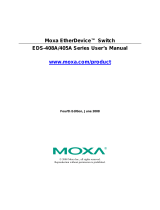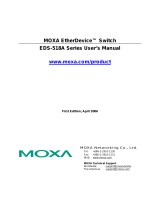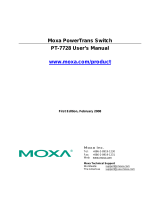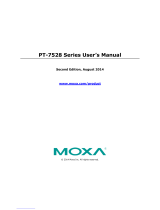Page is loading ...

TN Series Managed Ethernet Switch
User’s Manual
Version 2.4, July 2019
www.moxa.com/product
© 2019 Moxa Inc. All rights reserved.

TN Series Managed Ethernet Switch
User’s Manual
The software described in this manual is furnished under a license agreement and may be used only in accordance
with the terms of that agreement.
Copyright Notice
© 2019 Moxa Inc. All rights reserved.
Trademarks
The MOXA logo is a registered trademark of Moxa Inc.
All other trademarks or registered marks in this manual belong to their respective manufacturers.
Disclaimer
Information in this document is subject to change without notice and does not represent a commitment on the part of
Moxa.
Moxa provides this document as is, without warranty of any kind, either expressed or implied, including, but not
limited to, its particular purpose. Moxa reserves the right to make improvements and/or changes to this manual, or to
the products and/or the programs described in this manual, at any time.
Information provided in this manual is intended to be accurate and reliable. However, Moxa assumes no responsibility
for its use, or for any infringements on the rights of third parties that may result from its use.
This product might include unintentional technical or typographical errors. Changes are periodically made to the
information herein to correct such errors, and these changes are incorporated into new editions of the publication.
Technical Support Contact Information
www.moxa.com/support
Moxa Americas
Toll
-free: 1-888-669-2872
Tel:
+1-714-528-6777
Fax:
+1-714-528-6778
Moxa China (Shanghai office)
Toll
-free: 800-820-5036
Tel:
+86-21-5258-9955
Fax:
+86-21-5258-5505
Moxa Europe
Tel:
+49-89-3 70 03 99-0
Fax:
+49-89-3 70 03 99-99
Moxa Asia
-Pacific
Tel:
+886-2-8919-1230
Fax:
+886-2-8919-1231
Moxa India
Tel:
+91-80-4172-9088
Fax:
+91-80-4132-1045

Table of Contents
1. About this Manual ............................................................................................................................. 1-1
2. Getting Started.................................................................................................................................. 2-1
Serial Console Configuration (115200, None, 8, 1, VT100) ....................................................................... 2-2
Configuration by Telnet Console ........................................................................................................... 2-4
Configuration by Web Browser ............................................................................................................. 2-6
Disabling Telnet and Browser Access ..................................................................................................... 2-7
3. Featured Functions ........................................................................................................................... 3-1
Configuring Basic Settings ................................................................................................................... 3-2
System Identification ................................................................................................................... 3-2
Password (User Account) .............................................................................................................. 3-3
Password Login Policy .................................................................................................................. 3-5
Accessible IP List ......................................................................................................................... 3-6
Port Settings ............................................................................................................................... 3-7
Network Parameters .................................................................................................................... 3-8
GARP Timer Parameters ............................................................................................................. 3-10
System Time Settings ................................................................................................................ 3-11
IEEE 1588 PTP .......................................................................................................................... 3-12
System File Update .................................................................................................................... 3-17
Security ................................................................................................................................... 3-19
Restart ..................................................................................................................................... 3-26
Reset to Factory Default ............................................................................................................. 3-27
Loop Protection ......................................................................................................................... 3-27
Using Port Trunking .......................................................................................................................... 3-27
The Port Trunking Concept ......................................................................................................... 3-28
Port Trunking Settings ............................................................................................................... 3-28
Configuring SNMP ............................................................................................................................. 3-30
SNMP Read/Write Settings .......................................................................................................... 3-31
Trap Settings ............................................................................................................................ 3-32
Private MIB Information ............................................................................................................. 3-33
Using PoE (PoE Models Only) .............................................................................................................. 3-33
Type 1 ..................................................................................................................................... 3-34
Type 2 ..................................................................................................................................... 3-37
Type 3 ..................................................................................................................................... 3-47
Using Traffic Prioritization .................................................................................................................. 3-56
The Traffic Prioritization Concept ................................................................................................. 3-56
Configuring Traffic Prioritization .................................................................................................. 3-58
Using Virtual LAN .............................................................................................................................. 3-61
The Virtual LAN (VLAN) Concept .................................................................................................. 3-61
Sample Applications of VLANs Using Moxa Switches ....................................................................... 3-63
Configuring Virtual LAN .............................................................................................................. 3-64
Q in Q Setting ........................................................................................................................... 3-67
VLAN Table ............................................................................................................................... 3-67
Using Multicast Filtering ..................................................................................................................... 3-68
The Concept of Multicast Filtering ................................................................................................ 3-68
Configuring IGMP Snooping ........................................................................................................ 3-71
Current Active IGMP Streams ...................................................................................................... 3-73
Static Multicast MAC Addresses ................................................................................................... 3-74
Configuring GMRP...................................................................................................................... 3-75
GMRP Table .............................................................................................................................. 3-75
Multicast Filtering Behavior ......................................................................................................... 3-76
Using Bandwidth Management ............................................................................................................ 3-76
Configuring Bandwidth Management ............................................................................................ 3-76
Using Auto Warning .......................................................................................................................... 3-80
Configuring Email Warning ......................................................................................................... 3-80
Configuring Relay Warning ......................................................................................................... 3-83
Event Log Settings .................................................................................................................... 3-84
Using Line-Swap-Fast-Recovery .......................................................................................................... 3-85
Configuring Line-Swap Fast Recovery .......................................................................................... 3-85
DNS Server ...................................................................................................................................... 3-85
Using Set Device IP ........................................................................................................................... 3-86
Configuring Set Device IP (Type 1) .............................................................................................. 3-87
Configuring Set Device IP (Type2) ............................................................................................... 3-88
Configuring DHCP Relay Agent .................................................................................................... 3-90
Configuring DHCP Filter .............................................................................................................. 3-91
Using Diagnosis ................................................................................................................................ 3-92
Mirror Port ................................................................................................................................ 3-92
Ping ......................................................................................................................................... 3-93
LLDP Function ........................................................................................................................... 3-93

Using Monitor ................................................................................................................................... 3-94
Monitor by Switch ...................................................................................................................... 3-94
Monitor by Port ......................................................................................................................... 3-95
Using the MAC Address Table ............................................................................................................. 3-95
Using Access Control List ................................................................................................................... 3-96
The ACL Concept ....................................................................................................................... 3-96
Access Control List Configuration and Setup ................................................................................. 3-97
Using Event Log ............................................................................................................................. 3-101
Using Syslog .................................................................................................................................. 3-102
Using Industrial Protocols ................................................................................................................ 3-102
EtherNet/IP ............................................................................................................................ 3-102
Modbus TCP ............................................................................................................................ 3-103
Using HTTPS/SSL ............................................................................................................................ 3-103
A. MIB Groups ....................................................................................................................................... A-1

1
1. About this Manual
Thank you for purchasing a Moxa managed Ethernet switch. Read this user’s manual to learn how to
connect your Moxa switch to Ethernet-enabled devices used for industrial applications.
The following two chapters are covered in this user manual:
Getting Started
This chapter explains how the initial installation process for Moxa switch. There are three ways to access
Moxa switch's configuration settings: the serial console, Telnet console, and web console.
Featured Functions
This chapter explains how to access Moxa switch's various configuration, monitoring, and administration
functions. These functions can be accessed by serial, Telnet, or web console. The web console is the
most user-friendly way to configure Moxa switch. In this chapter, we use the web console interface to
introduce the functions.

2
2. Getting Started
In this chapter we explain how to install a Moxa switch for the first time. There are three ways to access the
Moxa switch’s configuration settings: serial console, Telnet console, or web console. If you do not know the
Moxa switch’s IP address, you can open the serial console by connecting the Moxa switch to a PC’s COM port
with a short serial cable. You can open the Telnet or web console over an Ethernet LAN or over the Internet.
The following topics are covered in this chapter:
Serial Console Configuration (115200, None, 8, 1, VT100)
Configuration by Telnet Console
Configuration by Web Browser
Disabling Telnet and Browser Access

TN Series Managed Ethernet Switches Getting Started
2-2
Serial Console Configuration (115200, None, 8,
1, VT100)
NOTE
•
You cannot connect to the serial and Telnet console at the same time.
•
You can connect to the web console and another console (serial or Telnet) at the same time. However,
we strongly recommend that you do NOT do so. Following this advice will allow you to maintain better
control over the Moxa switch’s configuration.
NOTE
We recommend
using PComm Terminal Emulator when opening the serial console. This software can
be downloaded free of charge from the Moxa website.
Before running PComm Terminal Emulator, use an RJ45 to DB9-F (or RJ45 to DB25-F) cable to connect the
Moxa switch’s console port to your PC’s COM port (generally COM1 or COM2, depending on how your system
is set up).
After installing PComm Terminal Emulator, open the Moxa switch’s serial console as follows:
1. From the Windows desktop, click Start
Programs
PComm Lite 1.3
Terminal Emulator.
2. Select Open under the Port Manager menu to open a new connection.
3. The Property window should open. On the Communication Parameter tab for Ports, select the COM
port that is being used for the console connection. Set the other fields as follows: 115200 for Baud
Rate, 8 for Data Bits, None for Parity, and 1 for Stop Bits.

TN Series Managed Ethernet Switches Getting Started
2-3
4. On the Terminal tab, select VT100 for Terminal Type, and then click OK to continue.
5. In the terminal window, the Moxa switch will prompt you to select a terminal type. Enter 1 to select
ansi/vt100 and then press Enter.
6. The serial console will prompt you to log in. Press Enter and select admin or user. Use the down arrow
key on your keyboard to select the Password field and enter a password if desired. This password will
be required to access any of the consoles (web, serial, Telnet). If you do not wish to create a password,
leave the Password field blank and press Enter.
7. The Main Menu of the Moxa switch’s serial console should appear. (In PComm Terminal Emulator, you
can adjust the font by selecting Font… from the Edit menu.)

TN Series Managed Ethernet Switches Getting Started
2-4
8. Use the following keys on your keyboard to navigate the Moxa switch’s serial console:
Key Function
Up, down, right, left arrow keys, Tab Move the onscreen cursor
Enter Display and select options
Space Toggle options
Esc Previous menu
Configuration by Telnet Console
Opening the Moxa switch’s Telnet or web console over a network requires that the PC host and Moxa switch
are on the same logical subnet. You may need to adjust your PC host’s IP address and subnet mask. By
default, the Moxa switch’s IP address is 192.168.127.253 and the Moxa switch’s subnet mask is
255.255.255.0 (referred to as a Class B network). Your PC’s IP address must be set to 192.168.xxx.xxx if
the subnet mask is 255.255.0.0, or to 192.168.127.xxx if the subnet mask is 255.255.255.0.
NOTE
To connect to the Moxa switch’s Telnet or web console, your PC host and the Moxa switch must be on the
same logical subnet.
NOTE
When connecting to the Moxa switch’s Telnet or web console, first connect one of the Moxa switch’s
Ethernet ports to your Ethernet LAN, or directly to your PC’s Ethernet port. You may use either a straight
-
through or cross
-over Ethernet cable.
NOTE
The
Moxa switch’s default IP address is 192.168.127.253.
After making sure that the Moxa switch is connected to the same LAN and logical subnet as your PC, open
the Moxa switch’s Telnet console as follows:
1. Click Start
Run from the Windows Start menu and then Telnet to the Moxa switch’s IP address from
the Windows Run window. You may also issue the Telnet command from a DOS prompt.
2. In the terminal window, the Telnet console will prompt you to select a terminal type. Type 1 to choose
ansi/vt100, and then press Enter.

TN Series Managed Ethernet Switches Getting Started
2-5
3. The Telnet console will prompt you to log in. Press Enter and then select admin or user. Use the down
arrow key on your keyboard to select the Password field and enter a password if desired. This
password will be required to access any of the consoles (web, serial, Telnet). If you do not wish to create
a password, leave the Password field blank and press Enter.
4. The Main Menu of the Moxa switch’s Telnet console should appear.
5. In the terminal window, select Preferences… from the Terminal menu on the menu bar.
6. The Terminal Preferences window should appear. Make sure that VT100 Arrows is checked.
7. Use the following keys on your keyboard to navigate inside the Moxa switch’s Telnet console:
Key Function
Up, down, right, left arrow keys, Tab Move the onscreen cursor
Enter Display and select options
Space
Toggle options
Esc Previous menu
NOTE
The Telnet console looks and operates in precisely the same
manner as the serial console.

TN Series Managed Ethernet Switches Getting Started
2-6
Configuration by Web Browser
The Moxa switch’s web console is a convenient platform for modifying the configuration and accessing the
built-in monitoring and network administration functions. You can open the Moxa switch’s web console using
a standard web browser, such as Internet Explorer.
NOTE
To connect to the Moxa switch’s Telnet or web console, your PC host and the Moxa switch must be on the
same logical subnet.
NOTE
If the Moxa switch is configured for othe
r VLAN settings, you must make sure your PC host is on the
management VLAN.
NOTE
When connecting to the Moxa switch’s Telnet or web console, first connect one of the Moxa switch’s
Ethernet ports to your Ethernet LAN, or directly to your PC’s Ethernet
port. You may use either a straight-
through or cross
-over Ethernet cable.
NOTE
The Moxa switch’s default IP address is 192.168.127.253.
After making sure that the Moxa switch is connected to the same LAN and logical subnet as your PC, open
the Moxa switch’s web console as follows:
1. Connect your web browser to the Moxa switch’s IP address by entering it in the Address or URL field.
2. The Moxa switch’s web console will open, and you will be prompted to log in. Select the login account
(admin or user) and enter the Password. This password will be required to access any of the consoles
(web, serial, Telnet). If you do not wish to create a password, leave the Password field blank and press
Enter.
NOTE
By default, the password assigned to the Moxa switch is
moxa. Be sure to change the default password
after you first log in to help keep your system secure.

TN Series Managed Ethernet Switches Getting Started
2-7
3. After logging in, you may need to wait a few moments for the web console to appear. Use the folders in
the left navigation panel to navigate between different pages of configuration options.
Disabling Telnet and Browser Access
If you are connecting the Moxa switch to a public network but do not intend to manage it over the network,
we suggest disabling both the Telnet and web consoles. This is done from the serial console by navigating to
System Identification under Basic Settings. Disable or enable the Telnet Console and Web
Configuration as shown below:

3
3. Featured Functions
In this chapter, we explain how to access the Moxa switch’s various configuration, monitoring, and
administration functions. These functions can be accessed by serial, Telnet, or web console. The serial
console can be used if you do not know the Moxa switch’s IP address and requires that you connect the
Moxa switch to a PC COM port. The Telnet and web consoles can be opened over an Ethernet LAN or the
Internet.
The web console is the most user-friendly interface for configuring a Moxa switch. In this chapter, we use
the web console interface to introduce the functions. There are only a few differences between the web
console, serial console, and Telnet console.
The following topics are covered in this chapter:
Configuring Basic Settings
Using Port Trunking
Configuring SNMP
Using PoE (PoE Models Only)
Using Traffic Prioritization
Using Virtual LAN
Using Multicast Filtering
Using Bandwidth Management
Using Auto Warning
Using Line-Swap-Fast-Recovery
DNS Server
Using Set Device IP
Using Diagnosis
Using Monitor
Using the MAC Address Table
Using Access Control List
Using Event Log
Using Syslog
Using Industrial Protocols
Using HTTPS/SSL

TN Series Managed Ethernet Switches Featured Functions
3-2
Configuring Basic Settings
The Basic Settings section includes the most common settings required by administrators to maintain and
control a Moxa switch.
System Identification
System Identification items are displayed at the top of the web console and will be included in alarm
emails. You can configure the System Identification items to make it easier to identify different switches
that are connected to your network.
Switch Name
Setting Description Factory Default
Max. 35 characters This option is useful for differentiating between the roles or
applications of different units. Example: Factory Switch 1.
Managed
Redundant Switch
[Serial no. of this
switch]
Switch Location
Setting Description Factory Default
Max. 80 characters This option is useful for differentiating between the locations
of different units. Example: production line 1.
Switch Location

TN Series Managed Ethernet Switches Featured Functions
3-3
Switch Description
Setting Description Factory Default
Max. 30 characters This option is useful for recording a more detailed description
of the unit.
Switch Model Name
Maintainer Contact Info
Setting Description Factory Default
Max. 30 characters This option is useful for providing information about who is
responsible for maintaining this unit and how to contact this
person.
None
Auto-logout (S)
Setting Description Factory Default
60 to 86400 (seconds) Disable or extend the auto-logout time for the web
management console.
300
Age Time (S)
Setting Description Factory Default
15 to 3825 (seconds) The length of time that a MAC address entry can remain in
the Moxa switch. When an entry reaches its aging time, it
“ages out” and is purged from the switch, effectively
cancelling frame forwarding to that specific port.
300
Web Login Message
Setting Description Factory Default
Max. 240 characters This option is useful as it shows a message when a user’s
login is successful.
None
Login Authentication Failure Message
Setting Description Factory Default
Max. 240 characters This option is useful as it shows a message when a user’s
login has failed.
None
CPU Loading
Setting Description Factory Default
Read-only The CPU usage volume in the past 5 seconds, 30 seconds,
and 5 minutes
None
Free Memory
Setting Description Factory Default
Read-only The immediately free memory of the switch None
Password (User Account)
The Moxa switch supports the management of accounts, including establishing, activating, modifying,
disabling, and removing accounts. There are two levels of configuration access: admin and user. Accounts
with admin authority have read/write access of all configuration parameters, whereas accounts with user
authority only have read access to view configuration items.
NOTE
1.
In order to maintain a higher level of security, we strongly suggest that you change the password after
you first log in.
2.
By default, the admin user account cannot be deleted or disabled.

TN Series Managed Ethernet Switches Featured Functions
3-4
Active
Setting Description Factory Default
Checked This account can access the switch’s configuration settings. Checked
Unchecked This account cannot access the switch’s configuration
settings.
Authority
Setting Description Factory Default
admin This account has read/write access of all configuration
parameters.
admin
user This account can only view configuration parameters.
Creating a New Account
Click Create, type in the user name and password, and assign an authority to the new account. Click Apply
to add the account to the Account List table.
Setting Description Factory Default
User Name (Max. 30
characters)
User Name None
Password Password for the user account (between 4 and 16 characters) None
Modifying an Existing Account
Select an existing account from the Account List table, modify the account details, and then click Apply to
save the changes.

TN Series Managed Ethernet Switches Featured Functions
3-5
Deleting an Existing Account
Select an account from the Account List table and then click Delete to delete the account.
Password Login Policy
In order to prevent hackers from cracking the password, Moxa switches allow users to configure a password
for their account and lock the account in the event that the wrong password is entered. The account
password policy requires passwords to be of a minimum length and complexity with a strength check. If
Account Login Failure Lockout is enabled, you will need to configure the Retry Failure Threshold and
Lockout Time parameters. If the number of login attempts exceeds the Retry Failure Threshold, users will
need to wait the number of minutes configured in Lockout Time before trying again.

TN Series Managed Ethernet Switches Featured Functions
3-6
Accessible IP List
The Moxa switch uses an IP address-based filtering method to control access.
You may add or remove IP addresses to limit access to the Moxa switch. When the accessible IP list is
enabled, only addresses on the list will be allowed access to the Moxa switch. Each IP address and netmask
entry can be tailored for different situations:
• Grant access to one host with a specific IP address
For example, enter IP address 192.168.1.1 with netmask 255.255.255.255 to allow access to
192.168.1.1 only.
• Grant access to any host on a specific subnetwork
For example, enter IP address 192.168.1.0 with netmask 255.255.255.0 to allow access to all IPs on the
subnet defined by this IP address/subnet mask combination.
• Grant access to all hosts
Make sure the accessible IP list is not enabled. Remove the checkmark from Enable the accessible IP
list.
The following table shows additional configuration examples:
Hosts That Need Access Input Format
Any host Disable
192.168.1.120 192.168.1.120 / 255.255.255.255
192.168.1.1 to 192.168.1.254 192.168.1.0 / 255.255.255.0
192.168.0.1 to 192.168.255.254 192.168.0.0 / 255.255.0.0
192.168.1.1 to 192.168.1.126 192.168.1.0 / 255.255.255.128
192.168.1.129 to 192.168.1.254 192.168.1.128 / 255.255.255.128

TN Series Managed Ethernet Switches Featured Functions
3-7
Port Settings
Ethernet Port Settings
Port settings are included to give the user control over port access, port transmission speed, flow control,
and port type (MDI or MDIX).
Enable
Setting Description Factory Default
Checked Allows data transmission through the port. Enabled
Unchecked Immediately shuts off port access.
ATTENTION
If a connected device or sub
-network is wreaking havoc on the rest of the network, the Disable option
under
Advanced Settings/Port gives the administrator a quick way to shut off access through this port
immediately.
Description
Setting Description Factory Default
Media type Displays the media type for each module’s port N/A
Name
Setting Description Factory Default
Max. 63 characters Specifies an alias for the port to help administrators
differentiate between different ports. Example: PLC 1
None
Speed
Setting Description Factory Default
Auto
Allows the port to use the IEEE 802.3u protocol to negotiate
with connected devices. The port and connected devices will
determine the best speed for that connection.
Auto
1G-Full
Choose one of these fixed speed options if the connected
Ethernet device has trouble auto-negotiating for line speed.
100M-Full
100M-Half
10M-Full
10M-Half

TN Series Managed Ethernet Switches Featured Functions
3-8
FDX Flow Ctrl
This setting enables or disables flow control for the port when the port’s Speed is set to Auto. The final
result will be determined by the Auto process between the Moxa switch and connected devices.
Setting Description Factory Default
Enable
Enables flow control for this port when the port’s Speed is set
to Auto.
Disabled
Disable
Disables flow control for this port when the port’s Speed is set
to Auto.
MDI/MDIX
Setting Description Factory Default
Auto Allows the port to auto-detect the port type of the connected
Ethernet device and change the port type accordingly.
Auto
MDI Choose MDI or MDIX if the connected Ethernet device has
trouble auto-negotiating for port type.
MDIX
Network Parameters
Network configuration allows users to configure both IPv4 and IPv6 parameters for management access
over the network. The Moxa switch supports both IPv4 and IPv6, and can be managed through either of
these address types.
A brief explanation of each configuration item is given below.
/




